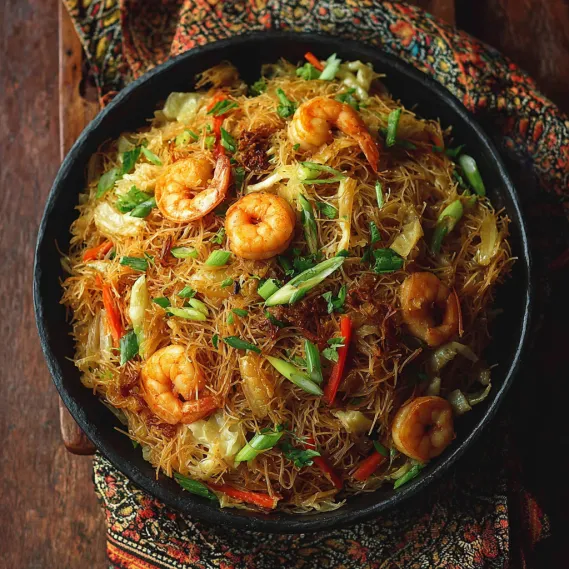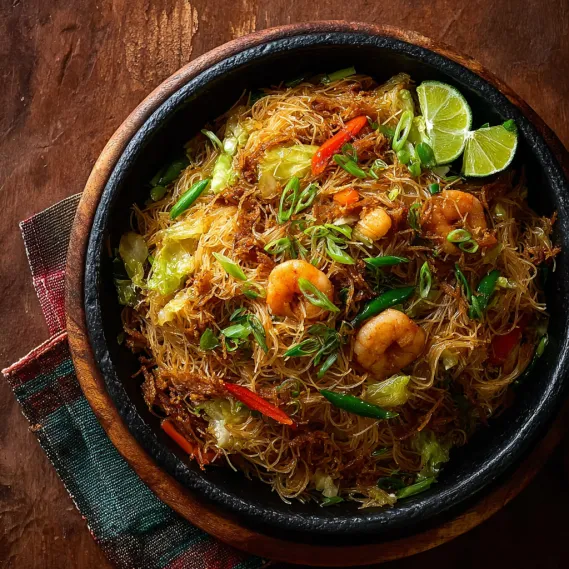 Pin
Pin
This traditional Pancit Bihon has been my go-to recipe whenever I want to impress guests with authentic Filipino cuisine without spending hours in the kitchen. The delicate rice noodles soak up the savory sauce while colorful vegetables and protein make it a complete one-dish meal.
I first learned this recipe from my Filipino neighbor during a community potluck where her pancit disappeared within minutes. After begging for the recipe, I've made it countless times for my family, tweaking it slightly each time until reaching this perfect version.
Ingredients
- Filipino Bihon Noodles: crucial for authentic texture and flavor. Look for packages labeled rice vermicelli or rice stick noodles if you can't find ones specifically labeled bihon
- Chicken Breast: adds lean protein. Choose boneless skinless for easiest preparation
- Small Shrimp: brings a delicate seafood flavor that complements the dish perfectly. Fresh is best but frozen works well too
- Fresh Green Beans: provide crisp texture and vibrant color. Select bright green beans with no blemishes
- Carrot: adds natural sweetness and beautiful color contrast. Choose firm orange carrots
- Cabbage: creates volume and absorbs the flavors beautifully. Look for tight heavy heads with no browning
- Yellow Onion: forms the aromatic base of the dish. Choose firm onions with no soft spots
- Minced Garlic: infuses the entire dish with essential flavor. Fresh is significantly better than jarred
- Sauce Ingredients: blend to create the signature pancit flavor profile with savory depth
Step-by-Step Instructions
- Soak the Noodles:
- Begin by placing dry rice vermicelli in a large bowl of cold water for at least 30 minutes. This crucial step softens the noodles without making them mushy and prevents them from clumping during cooking. The noodles should be pliable but not completely soft when done soaking.
- Cook the Proteins:
- Heat about two tablespoons of oil in a large wok or deep skillet over medium high heat until shimmering. Add thinly sliced chicken breast seasoned with a pinch of salt and pepper, allowing it to sear and develop golden edges before stirring. When chicken is nearly cooked through after about 3 minutes, add the shrimp and continue cooking just until they turn pink about 2 minutes more. Avoid overcooking the shrimp or they will become rubbery.
- Build the Flavor Base:
- Add diced onions and minced garlic to the proteins, stirring constantly to prevent burning. Cook until the onions become translucent and the garlic becomes fragrant which takes approximately 2 minutes. This aromatic foundation will infuse the entire dish with essential flavor.
- Add Vegetables:
- Introduce green beans, carrots, and cabbage to the wok, stirring frequently to combine with proteins and aromatics. Allow vegetables to cook until they begin to soften but still maintain some crispness about 4 minutes. The cabbage will reduce in volume significantly as it releases moisture.
- Create the Sauce:
- Whisk together chicken bouillon powder, both soy sauces, oyster sauce, water and accent if using until completely combined. Pour this mixture over the sautéed ingredients in the wok, stirring well to ensure everything is coated in the flavorful liquid.
- Finish with Noodles:
- Drain the soaked noodles thoroughly and add them to the wok along with approximately 2 cups of water. Cover the wok with a lid to trap steam which helps cook the noodles. Check and stir every couple of minutes to prevent sticking as the noodles absorb the liquid and flavors. The dish is ready when noodles are tender but not mushy and most liquid has been absorbed about 5 to 6 minutes.

The oyster sauce in this recipe is my secret weapon for authentic pancit. I learned from my Filipino friends that this ingredient provides that distinctive umami depth that many homemade versions miss. I always keep a bottle in my refrigerator specifically for this dish.
Serving Suggestions
Pancit Bihon is traditionally served at Filipino celebrations because it symbolizes long life and good health. Serve it family style on a large platter garnished with lime wedges and allow guests to squeeze fresh lime juice over their portions. The bright acidity balances the savory flavors perfectly.
For a complete Filipino feast, pair your pancit with lumpia spring rolls and a simple green salad. Some families also enjoy serving pancit with steamed white rice, though this makes for a very carbohydrate heavy meal.
Storage and Reheating
Pancit Bihon stores beautifully in airtight containers in the refrigerator for up to 4 days. The flavors actually develop and improve overnight, making this an excellent meal prep option. When reheating, add a small splash of water to the portion and either microwave covered or gently reheat in a skillet over medium heat.
Avoid freezing pancit as the noodle texture significantly deteriorates when thawed. If you want to prepare components ahead, you can freeze the cooked protein and vegetable mixture without the noodles, then simply cook fresh noodles when ready to serve.
Ingredient Substitutions
While traditional bihon noodles are essential for authentic pancit, you can make reasonable substitutions for other ingredients based on availability. Pork or beef can replace chicken, though cooking times will vary slightly. For a vegetarian version, use firm tofu and vegetable broth instead of chicken bouillon.
If you cannot find fresh vegetables, frozen green beans and carrots work well when added directly to the wok without thawing. Napa cabbage makes an excellent substitute for regular cabbage, offering a slightly sweeter flavor profile.
Common Questions About This Recipe
- → Why is soaking the noodles important?
Soaking ensures the rice noodles soften properly and cook evenly, absorbing the dish's flavors without turning mushy.
- → Can I substitute the proteins?
Traditional versions use chicken and shrimp, but sliced pork or tofu may also provide delicious alternatives based on preference.
- → What vegetables work best in this dish?
Cabbage, carrots, and green beans create a classic flavor and satisfying texture. Feel free to add bell peppers or snap peas for variety.
- → How do I achieve the right noodle texture?
Pre-soak the noodles for at least 30 minutes, then cook them gently in the sauce mixture, stirring to prevent sticking.
- → What garnishes enhance the final dish?
Fresh lime wedges, scallions, or fried garlic elevate the flavors and add brightness to each serving.
- → Can this meal be made ahead?
Yes, Pancit Bihon holds up well for several hours and can be reheated, though noodles may soften more over time.
